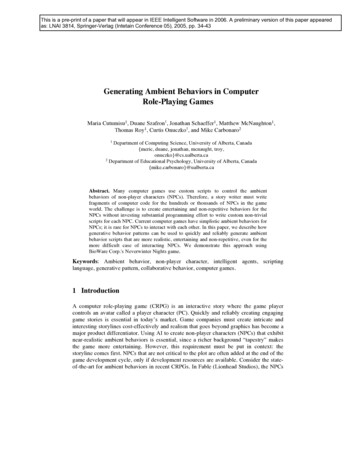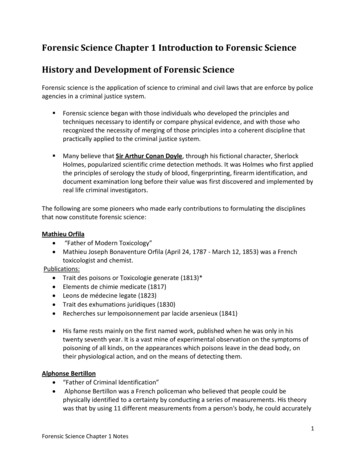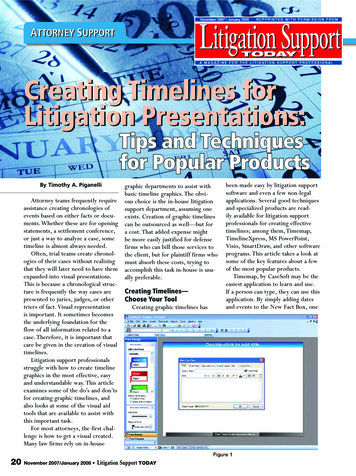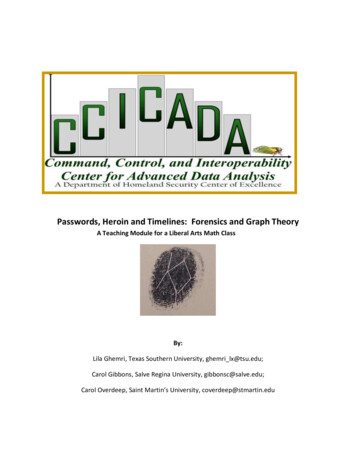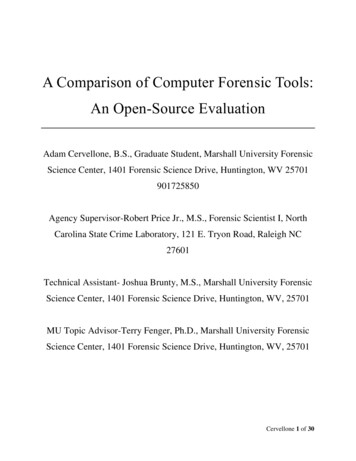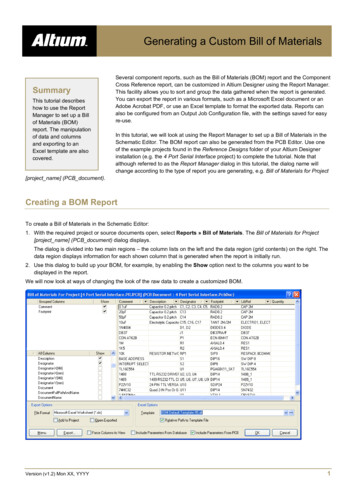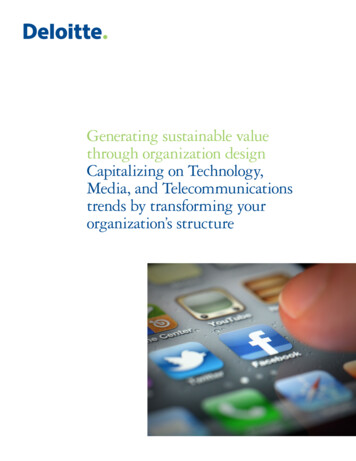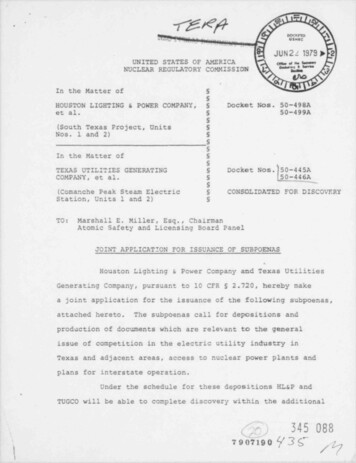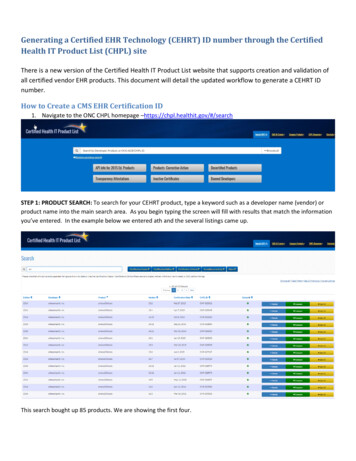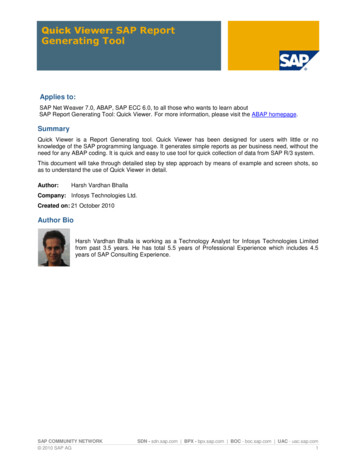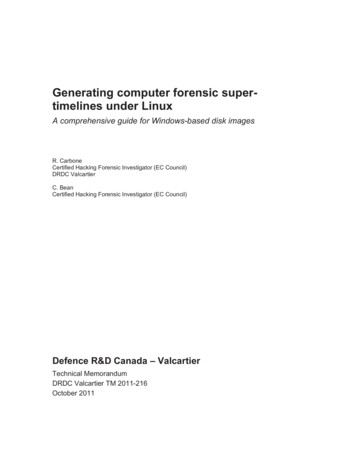
Transcription
Generating computer forensic supertimelines under LinuxA comprehensive guide for Windows-based disk imagesR. CarboneCertified Hacking Forensic Investigator (EC Council)DRDC ValcartierC. BeanCertified Hacking Forensic Investigator (EC Council)Defence R&D Canada – ValcartierTechnical MemorandumDRDC Valcartier TM 2011-216October 2011
Principal AuthorOriginal signed by Richard CarboneRichard CarboneProgrammer/AnalystApproved byOriginal signed by Guy TurcotteGuy TurcotteHead/System of SystemsApproved for release byOriginal signed by Christian CarrierChristian CarrierChief Scientist Her Majesty the Queen in Right of Canada, as represented by the Minister of National Defence, 2011 Sa Majesté la Reine (en droit du Canada), telle que représentée par le ministre de la Défense nationale,2011
Abstract .This technical memorandum examines the basics surrounding computer forensic filesystemtimelines and provides an enhanced approach to generating superior timelines for improvedfilesystem analysis and contextual awareness. Timelines are improved by polling multiplesources of information across the filesystem resulting in an approach that is surprisingly flexibleand customizable. The timeline is further enhanced by incorporating key time-based metadatafound across a disk image which, when taken as a whole, increases the forensic investigator’sunderstanding.Résumé .Ce mémorandum technique examine les bases entourant la création d’un calendrier desévénements inforensiques des systèmes de fichier et fournit une approche améliorée pour générerdes calendriers supérieurs pour une analyse améliorée des systèmes de fichiers et un meilleuréveil contextuel. Ces calendriers sont améliorés en sondant des sources multiples d’information àtravers le système de fichiers, ce qui résulte en une approche qui est étonnamment flexible etconfigurable. Le calendrier est amélioré encore davantage par l’introduction des métadonnéesessentielles liées au temps qui se retrouvent un peu partout sur un disque et qui, lorsque prises encompte globalement, augmentent la compréhension de l’enquêteur inforensique.DRDC Valcartier TM 2011-216i
This page intentionally left blank.iiDRDC Valcartier TM 2011-216
Executive summaryGenerating computer forensic super-timelines under Linux: Acomprehensive guide for Windows-based disk imagesCarbone, R., Bean, C.; DRDC Valcartier TM 2011-216; Defence R&D Canada –Valcartier; October 2011.Modern digital forensics relies on a multitude of software tools and investigative techniques in anattempt to understand and piece together the actions taken by a suspect. Many pieces of relevantinformation exist, including precious metadata. It is this metadata, specifically date/time relatedmetadata, which constitutes the main subject of this technical memorandum. Unfortunately, thefull utilization of said metadata is all too often left out from an investigation as only the basicfilesystem date/time metadata is actually used. Using additional metadata sources, as examinedin this technical memorandum, would further increase the confidence reliability of a digitalforensic timeline.These timelines, while in use for many years now by investigators, are lacking in context anddepth. Far too many important additional sources of date/time-related metadata are left out fromthe timeline, thereby limiting the investigator’s contextual understanding of events. Byincreasing the scope and range of additional metadata and pushing it into the timeline, newinsights can be gained, particularly into user-related activities.While these concepts are not new, they are not widely used today by investigators nor are theyimplemented into current commercial digital forensic analysis tools and frameworks. Instead,digital forensic timelines appear to have been ignored by the software industry. However, therehas been some resurgence of interest in timelines and the software tools at the forefront,log2timeline and The Sleuth Kit, play a key role in the timeline generation approach describedherein.Specifically, the open source tool log2timeline, in combination with custom shell scripts and shortC-based programs, will enable the reader to not only generate enhanced timelines from additionalsources of date/time-related metadata but allow for said generation in a more automatablefashion. This technical memorandum therefore provides a detailed description of the authors’approach to generating enhanced timelines in the hopes of aiding the digital forensic communityto adopt improved methodologies.This work was carried out over a period of two months as part of the Live Computer Forensicsproject, an agreement between DRDC Valcartier and the RCMP (SRE-09-015, 31XF20). Theresults of this project will be of great interest to the Canadian Forces Network Operation(CFNOC) in their mission of securing DND networks and investigating computer incidents.DRDC Valcartier TM 2011-216iii
Sommaire .Generating computer forensic super-timelines under Linux: Acomprehensive guide for Windows-based disk imagesCarbone, R., Bean, C. ; DRDC Valcartier TM 2011-216 ; R & D pour la défenseCanada – Valcartier; octobre 2011.L’inforensique moderne repose sur une multitude d’outils logiciels et de techniques d’enquêtedans le but de comprendre et de réunir les actes commis par un suspect. Beaucoup d’informationpertinente existe, incluant de précieuses métadonnées. Ce sont ces métadonnées, partiellementcelles liées à la date et à l’heure, qui constituent le sujet principal de ce mémorandum technique.Malheureusement, la pleine utilisation de ces métadonnées est trop souvent mise de côté dans uneenquête et seules les métadonnées de base du système de fichiers, liées à la date et à l’heure, sontutilisées dans les faits. L’utilisation de sources de métadonnées additionnelles, tellesqu’examinées dans ce mémorandum technique, augmenterait le niveau de fiabilité envers uncalendrier des événements inforensiques.Ces calendriers, pourtant utilisés depuis plusieurs années par les enquêteurs, manquentd’information contextuelle et de profondeur. Beaucoup trop de métadonnées additionnellesimportantes liées à la date et à l’heure sont mise à l’écart du calendrier, ce qui limite lacompréhension contextuelle des événements pour l’enquêteur. En augmentant la portée et lagamme des métadonnées additionnelles et en les incluant dans le calendrier des événements, denouvelles connaissances peuvent être acquises, particulièrement en ce qui a trait aux activités desutilisateurs.Bien que ces concepts ne soient pas nouveaux, ils sont peu utilisés par les enquêteurs et ils ne sontpas implémentés dans les outils et cadres courants d’inforensique commerciaux. Les calendriersdes événements numériques semblent plutôt avoir été négligés par l’industrie logicielle. Malgrétout, il semble y avoir eu un regain d’intérêt pour ces calendriers et les outils logiciel à l’avantgarde, log2timeline et The Sleuth Kit, joue un rôle clé dans la production de calendriers desévénements décrits dans ce mémorandum.Spécifiquement, l’outil en logiciel libre log2timeline, combiné avec des scripts de commandespersonnalisés et de petits programmes en C, permettra au lecteur non seulement de produire descalendriers améliorés à partir de sources additionnelles de métadonnées liées à la date et à l’heure,mais permettra aussi une meilleure automatisation de cette production. Ce mémorandumtechnique fournit donc une description détaillée de l’approche des auteurs pour produire descalendriers des événements plus détaillés dans l’espoir d’aider la communauté inforensique àadopter des méthodes améliorées.Ce travail a été accompli sur une période de deux mois dans le cadre du projet « Live ComputerForensics », une entente entre RDDC Valcartier et la GRC (SRE-09-015, 31XF20). Les résultatsde ce projet seront d’un grand intérêt pour le Centre d'opérations des réseaux des Forcescanadiennes (CORFC) dans leur mission de protection des réseaux du MDN et d’investigationdes incidents informatiques.ivDRDC Valcartier TM 2011-216
This page intentionally left blank.DRDC Valcartier TM 2011-216v
Table of contentsAbstract . . i Résumé . . i Executive summary . iii Sommaire . iv Table of contents . vi List of tables . x Acknowledgements . xi Disclaimer xii C source code and Bash shell script code disclosure licensing agreement. xiii Requirements and assumptions . xiv Software requirements . xv Reasons why the timescanner tool was not used . xvi 1 Introduction. 1 1.1 Objective . 1 1.2 Context . 1 1.3 Benefits of improved timeline generation . 2 1.4 Notes . 2 2 Background information . 3 2.1 About digital timelines . 3 2.2 Reasons for using open source software for timeline generation . 4 2.2.1 Commercially used forensic analysis software background . 4 2.2.2 The use of Linux . 4 2.2.3 Use of The Sleuth Kit . 6 2.2.4 Use of log2timeline. 7 2.2.5 Linux capabilities. 8 2.3 Why are digital timelines underutilized? . 9 2.4 Timeline challenges . 10 2.5 Brief remarks concerning the implementation of timeline generation . 13 2.6 A short list and summary of available timeline generation software currently inuse . 13 2.6.1 Encase . 14 2.6.2 FTK . 14 2.6.3 Ex-Tip . 14 2.6.4 Log2timeline . 14 2.6.5 NTI FileList Pro . 14 2.6.6 The Sleuth Kit . 15 2.6.7 Autopsy . 15 viDRDC Valcartier TM 2011-216
2.6.8 2.6.9 2.6.10 2.6.11 2.6.12 2.6.13 2.6.14 2.6.15 2.6.16 PTK . 15 Zeitline . 15 AnalyzeMFT.py . 15 Fiwalk . 16 Mac-robber . 16 Digital Forensic Framework . 16 Grave-robber . 16 NFILabs Aftertime. 16 SIMILE Timeplot . 17 3 Filesystem-specific details . 18 3.1 Background . 18 3.2 Topics excluded from the filesystem analysis . 18 3.2.1 Specific filesystems . 18 3.2.2 Extended attributes . 19 3.2.3 A note about ACLs . 19 3.3 About MAC times, their limitations and consequences . 19 3.3.1 Background . 19 3.3.2 MAC times under Linux and UNIX . 20 3.3.3 MAC times under Windows . 21 3.3.3.1 FAT-based MAC times . 21 3.3.3.2 NTFS-based MAC times. 21 3.3.4 Final thoughts . 23 3.4 About file permissions . 24 3.4.1 Background . 24 3.4.2 A timeline-based representation of permissions . 24 3.4.3 Windows filesystem permissions. 25 3.4.3.1 FAT filesystem permissions. 25 3.4.3.2 NTFS filesystem permissions . 25 3.4.4 UNIX filesystem permissions . 27 4 Timeline formats . 29 4.1 Background . 29 4.2 Examination of the various timeline formats . 30 4.2.1 Preliminary timeline format . 30 4.2.1.1 Bodyfile timeline format . 30 4.2.2 Intermediate timeline formats . 33 4.2.2.1 TLN timeline format . 34 4.2.2.2 Mactime timeline format. 34 4.2.2.3 Other potential timeline formats . 37 4.2.3 Authors’ proposed enhanced Mactime timeline format for use as a finaltimeline layout . 38 4.2.3.1 Proposed timeline format specifics . 38 DRDC Valcartier TM 2011-216vii
4.3 4.4 4.2.3.2 Example of enhanced Mactime timeline format . 39 Reading and processing Mactime-based timeline output . 40 A final point about UNIX data processing . 42 5 Examining timeline-based sources of information . 43 5.1 Background . 43 5.2 Sources of date/time metadata . 43 5.2.1 Sources available through log2timeline . 43 5.2.2 Sources used and implemented in the proposed timeline extractionframework . 45 5.3 How the control script works . 46 5.4 Sample output . 47 5.4.1 Allocated filesystem objects . 47 5.4.2 Deleted filesystem objects . 48 5.4.3 Undeletable filesystem objects . 49 5.4.4 Windows registry objects . 50 5.4.5 Windows event logs . 51 5.4.6 Windows prefetch files . 52 5.4.7 Windows system restores . 53 5.4.8 Windows shortcuts. 54 5.4.9 Windows Internet Explorer history files .
The timeline is further enhanced by incorporating key time-based metadata found across a disk image which, when taken as a whole, increases th

